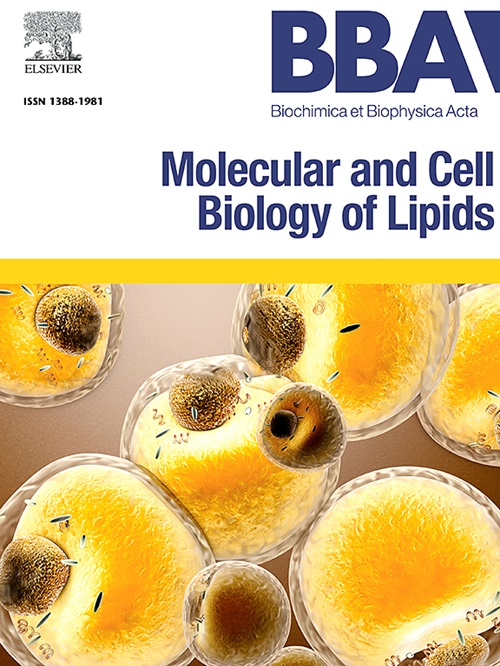Alterations in phosphatidylethanolamine metabolism impacts hepatocellular lipid storage, energy homeostasis, and proliferation
IF 3.3
2区 生物学
Q2 BIOCHEMISTRY & MOLECULAR BIOLOGY
Biochimica et biophysica acta. Molecular and cell biology of lipids
Pub Date : 2025-03-26
DOI:10.1016/j.bbalip.2025.159608
引用次数: 0
Abstract
Phosphatidylethanolamine (PE) is the second most abundant glycerophospholipid in eukaryotic membranes and is involved in several cellular processes. An important pathway for de novo PE synthesis is the Kennedy Pathway. The rate limiting enzyme in the pathway, CTP:phosphoethanolamine cytidyltransferase, catalyzes the synthesis of CDP-ethanolamine from phosphoethanolamine (pEtn) and CTP. Ethanolamine phosphate phospholyase (ETNPPL) has the potential to breakdown pEtn by catabolizing it to form acetaldehyde, ammonium, and inorganic phosphate. Research on this enzyme is limited and it is unclear how its activity affects PE synthesis; therefore, an investigation into ETNPPL's biological effects is required.
ETNPPL was expressed in human hepatoma cell line (Huh7) by stable transfection, allowing for long-term expression in cells without ETNPPL. We show that ETNPPL reduces cellular pEtn synthesized from ethanolamine, which decreased synthesis of PE and an increased PC:PE ratio, which has been shown to be associated with metabolic dysfunction-associated steatotic liver disease (MASLD) and impaired mitochondrial function. Experiments conducted show increased neutral lipid storage accompanied by decreased ATP production and oxygen consumption; however, no differences in triglyceride secretion were seen, although ApoB100 secretion was reduced. Huh7 cells expressing ETNPPL proliferate at a slower rate than control and have increased mRNA expression of p53 and tumor suppressor genes (CDKN1A, BBC3, BAX, BRCA1), implicating ETNPPL in cell proliferation, cancer development and/or tumor progression. Overall, ETNPPL rewires hepatic lipid metabolism, altering several processes including increasing lipid storage and decreasing proliferation. The impacts observed in this study may create a link between hepatic ETNPPL expression and MASLD/HCC pathophysiology.
磷脂酰乙醇胺代谢的改变影响肝细胞脂质储存、能量稳态和增殖
磷脂酰乙醇胺(PE)是真核生物膜中含量第二丰富的甘油磷脂,参与多种细胞过程。从头合成聚乙烯的一个重要途径是肯尼迪途径。该途径中的限速酶CTP (phosphoethanolamine cytidyltransferase)催化磷酸乙醇胺(pEtn)和CTP合成cdp -乙醇胺。乙醇胺磷酸磷酸化酶(ETNPPL)有可能分解pEtn,将其分解为乙醛、铵和无机磷酸盐。对该酶的研究有限,其活性如何影响PE合成尚不清楚;因此,有必要对ETNPPL的生物学效应进行调查。通过稳定转染,ETNPPL在人肝癌细胞系(Huh7)中表达,允许在没有ETNPPL的细胞中长期表达。我们发现,ETNPPL减少了由乙醇胺合成的细胞pEtn,从而减少了PE的合成,增加了PC:PE比率,这已被证明与代谢功能障碍相关的脂肪变性肝病(MASLD)和线粒体功能受损有关。实验表明,中性脂质储存增加,同时ATP生成和耗氧量减少;然而,虽然ApoB100的分泌减少,但甘油三酯的分泌没有差异。表达ETNPPL的Huh7细胞增殖速度比对照组慢,p53和肿瘤抑制基因(CDKN1A、BBC3、BAX、BRCA1)的mRNA表达增加,暗示ETNPPL参与细胞增殖、癌症发生和/或肿瘤进展。总的来说,ETNPPL重组了肝脏脂质代谢,改变了几个过程,包括增加脂质储存和减少增殖。本研究中观察到的影响可能在肝脏ETNPPL表达与MASLD/HCC病理生理之间建立联系。
本文章由计算机程序翻译,如有差异,请以英文原文为准。
求助全文
约1分钟内获得全文
求助全文
来源期刊
CiteScore
11.00
自引率
2.10%
发文量
109
审稿时长
53 days
期刊介绍:
BBA Molecular and Cell Biology of Lipids publishes papers on original research dealing with novel aspects of molecular genetics related to the lipidome, the biosynthesis of lipids, the role of lipids in cells and whole organisms, the regulation of lipid metabolism and function, and lipidomics in all organisms. Manuscripts should significantly advance the understanding of the molecular mechanisms underlying biological processes in which lipids are involved. Papers detailing novel methodology must report significant biochemical, molecular, or functional insight in the area of lipids.

 求助内容:
求助内容: 应助结果提醒方式:
应助结果提醒方式:


